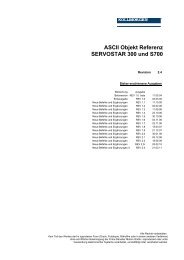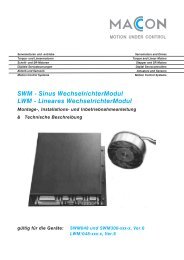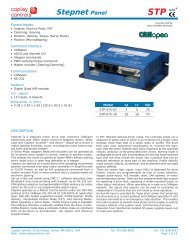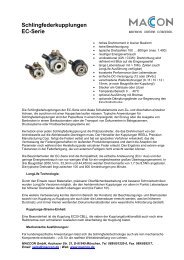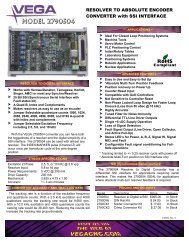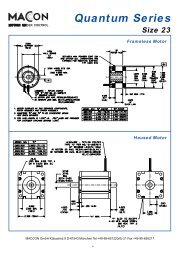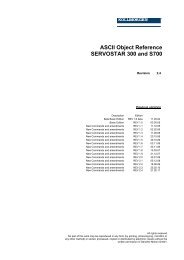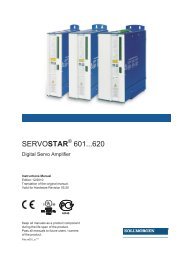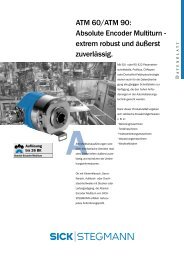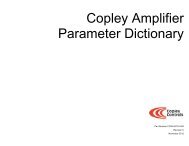CANopen Programmer's Manual - Maccon.de
CANopen Programmer's Manual - Maccon.de
CANopen Programmer's Manual - Maccon.de
You also want an ePaper? Increase the reach of your titles
YUMPU automatically turns print PDFs into web optimized ePapers that Google loves.
2: Network Management <strong>CANopen</strong> Programmer’s <strong>Manual</strong><br />
Overview<br />
<strong>CANopen</strong> object 0x2000 (sub-in<strong>de</strong>x 0) is used to send serial commands and retrieve the response<br />
from the amplifier. Each serial command consists of two parts, a command message sent to the<br />
amplifier, and a response message retrieved from it.<br />
Sending a command to the amplifier is done by writing to <strong>CANopen</strong> object 0x2000. The first byte<br />
sent is the command co<strong>de</strong> of the serial command to be executed. This is followed by any data<br />
bytes that are required for the command. Then, the response from the amplifier is retrieved by<br />
reading from object 0x2000. The first byte received will be an error co<strong>de</strong> (same error co<strong>de</strong>s as<br />
used in the serial interface). This is followed by zero or more bytes of response data.<br />
For example:<br />
To read actual position, the following bytes would be written to object 0x2000 using an SDO<br />
transfer:<br />
0x0C 0x17 0x00<br />
The first byte (0x0C) is the command co<strong>de</strong> for a GET command. The second and third bytes<br />
(0x17 0x00) make up the one word of data passed to a GET command. This data word (0x0017)<br />
is the variable ID that is to be read (in this case, variable 0x17, which is the actual position). The<br />
response is read from an SDO reading back the value of object 0x2000.<br />
For example:<br />
If the following data bytes were read from 0x2000:<br />
0x00 0x34 0x12 0x78 0x56<br />
The first byte gives an error co<strong>de</strong>. A zero here indicates no error. The next four bytes are the<br />
position read back from the amplifier. In this case, the position read back is 0x12345678.<br />
Byte or<strong>de</strong>r<br />
The byte or<strong>de</strong>r of data sent to or from the amplifier requires some further explanation.<br />
The amplifier (serial port interface) works internally with 16-bit words of data. All serial commands<br />
take zero or more words of data and return zero or more words. When 32-bit values are passed<br />
to or from the amplifier, they are always sent most significant word first. When this array of 16-bit<br />
words of data is sent over the <strong>CANopen</strong> interface, each word of data is split into two bytes.<br />
<strong>CANopen</strong> always sends data least significant byte first. Therefore, when a 32-bit value is sent over<br />
the <strong>CANopen</strong> interface, it's first split into two 16-bit words (most significant word followed by least<br />
significant word). Then, each word is split into two bytes using the <strong>CANopen</strong> standard of least<br />
significant byte followed by most significant.<br />
For example:<br />
The 32-bit value 0x12345678 would first be split into the words 0x1234 0x5678. These two words<br />
would then be split into the bytes 0x34 0x12 0x78 0x56.<br />
Any serial command that is processed by the main amplifier firmware (as opposed to the boot<br />
loa<strong>de</strong>r) can be sent over the <strong>CANopen</strong> interface using this method. Any command that needs to<br />
be sent to the boot loa<strong>de</strong>r (such as a firmware upload) cannot be sent using this method.<br />
50 Copley Controls




